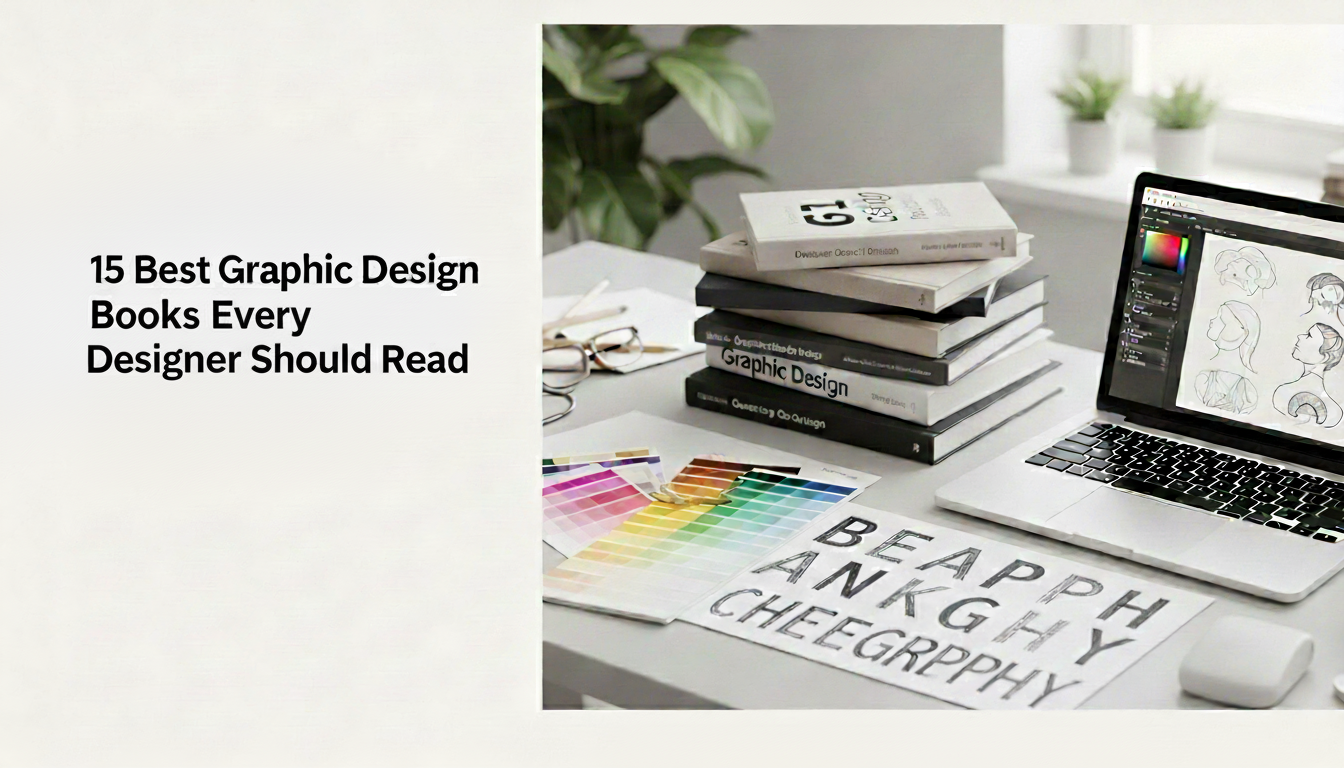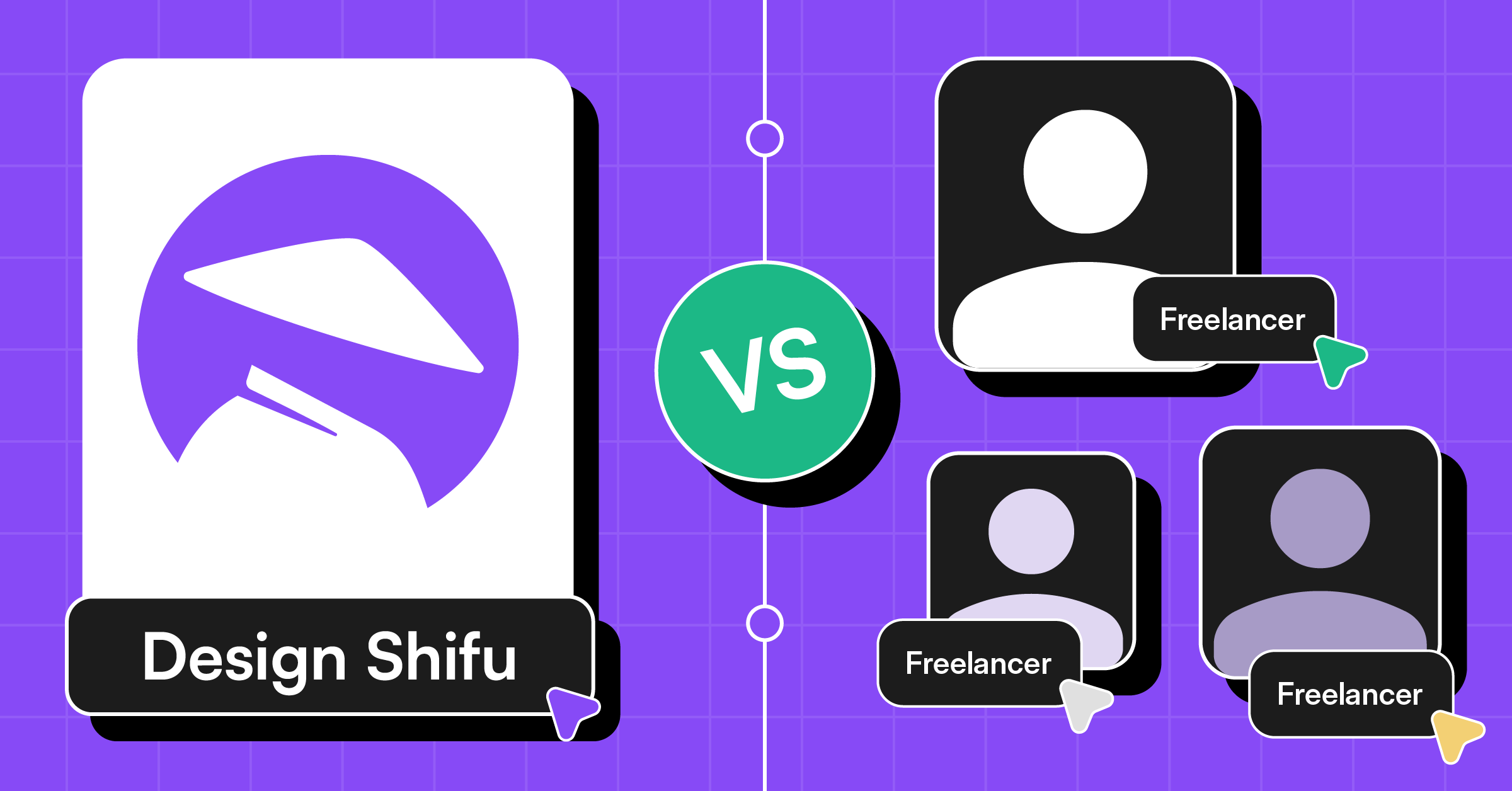Good design doesn’t come from watching YouTube tutorials alone. The best graphic design books teach you why things work, not just how to click buttons in Photoshop.
Whether you’re just starting or you’ve been designing for years, graphic design books give you something digital content can’t, deep knowledge that sticks with you. Plus, you can read them without getting distracted by notifications every five minutes.
This list covers the graphic design books that actually matter. Some are old classics that designers have loved for decades. Some are brand new releases for 2025. All of them will make you a better designer.
What You’ll Find in This Graphic Design Books Guide
This article covers 15 essential graphic design books for graphic designers at every level. You’ll learn what each book teaches, who should read it, and why it’s worth your time and money. We’ve also included 3 bonus books for specialized areas like lettering and motion design. Plus, we’ll show you exactly how to pick the right books based on your current skills and career goals.
The 15 Best Graphic Design Books
1. Best Graphic Design Books for Typography: Thinking with Type by Ellen Lupton
Ellen Lupton is a designer and teacher who knows how to explain complicated ideas in simple terms. This entry in our graphic design books list is the perfect introduction to typography for anyone who feels confused by all the rules about fonts.
The book covers everything from basic letter shapes to complex grid systems. But unlike boring textbooks, it’s full of colorful examples and real design projects. You’ll learn about serif vs. sans-serif fonts, how to space letters and lines properly, and how to create visual hierarchy with type.
One of the best parts is how Lupton connects old printing techniques to modern digital design. You’ll understand where typography rules came from and why they still matter today. The book also includes exercises you can try yourself.
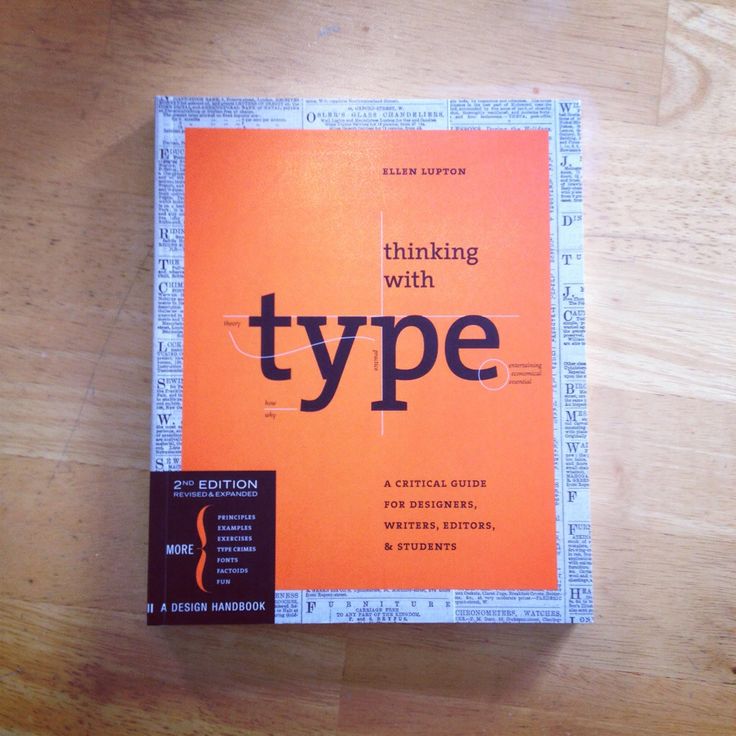
Why This Graphic Design Book Matters
- What makes it great: Lupton doesn’t assume you know anything. She starts with “What is a font?” and builds from there. The book is organized so you can read it cover-to-cover or jump to specific topics when you need help. Lupton’s book is fantastic for understanding type form, and for practical readability advice, you should pair it with our book typography guide on font readability.
- What You’ll Learn from This Graphic Design Book: How to choose fonts that work together. Why is some text easy to read, and other text isn’t? How spacing affects readability. The difference between tracking, kerning, and leading.
- Best for: Beginners who are tired of guessing which fonts to use. Also great for intermediate designers who want to fill gaps in their knowledge.
- Why you need it: Typography is everywhere in design. If you only read one typography book out of all these graphic design books, this should be it.
2. The Elements of Typographic Style by Robert Bringhurst
If “Thinking with Type” is typography school, this book is typography university. Robert Bringhurst is a poet and designer who treats typography as an art form. This isn’t a quick read, it’s dense, detailed, and sometimes poetic.
The book covers the history of type from ancient Rome to modern digital fonts. Bringhurst explains every tiny detail about how letters should be shaped, spaced, and arranged. He also includes beautiful examples from centuries of printed books.
What makes this book special is that it’s not just technical rules. Bringhurst explains the reason behind every choice. Why does this spacing feel calm? Why does that combination feel chaotic? He teaches you to see type as more than decoration.
The book is organized into sections on rhythm, proportion, harmony, and more. Each section builds on the last. There’s also a huge section on choosing and using specific typefaces, which is basically a reference guide you’ll use for years.

Why Every Designer Should Read This Graphic Design Book
- What makes it great: This book has been called the typography bible for good reason. Professional designers keep it on their desks and refer to it constantly. It’s also beautifully designed; the book itself is an example of perfect typography.
- What you’ll learn: Advanced typographic principles that separate amateur work from professional work. How to set type for books, magazines, and digital screens. The history and proper use of hundreds of typefaces.
- Best for: Intermediate to advanced designers who are serious about mastering typography. Not for complete beginners read Lupton first.
- Why you need it: Once you understand these principles, you’ll see bad typography everywhere and know exactly how to fix it with the help of great graphic design books.
3. Logo Design Love by David Airey
David Airey is a designer who specializes in brand identity, and this book shares everything he’s learned from years of client work. Unlike theoretical books, this one is super practical.
If you’re building your portfolio, this book from the graphic design books list offers real-world logo process, client stories, and pricing advice. It’s a great reference, especially if you’re working on case studies, and if you need inspiration for structuring your own. See how we built real brand identities for clients
The book walks through Airey’s actual logo design process from start to finish. You see how he talks to clients, researches competitors, sketches ideas, and presents final work. He includes case studies from real projects, showing both successful designs and ideas that didn’t work.
One chapter focuses on what makes logos effective: simplicity, relevance, and timelessness. Airey explains why logos like Nike and Apple work so well, and why trendy logos age poorly. He also covers practical stuff like file formats, pricing your work, and dealing with clients who want endless revisions.
The book includes interviews with famous logo designers, tips for presenting your work, and advice on building a portfolio. There’s also a section on common mistakes beginners make and how to avoid them.

Key Takeaways from This Graphic Design Book
- What makes it great: This isn’t just theory, it’s real-world advice from someone who does this for a living. The case studies show you exactly how professional logo design works.
- What you’ll learn: The complete logo design process. How to research and brainstorm effectively. How to present ideas to clients. What to include in brand guidelines. How much to charge for logo work.
- Best for: Anyone learning logo design, whether you’re a student or switching from other design areas. Essential for freelancers who want to offer branding services.
- Why you need it: Logo design looks simple, but there’s a lot more to it than drawing a cool symbol. This book is one of the very best graphic design books. It shows you the whole picture.
4. Designing Brand Identity by Alina Wheeler
While Airey’s book focuses on logos, Wheeler’s book covers complete brand identity systems. This is about everything logos, colors, fonts, patterns, photography style, tone of voice, and more.
The book is structured like a brand project. It starts with research and strategy, moves through design development, and ends with implementation across all touchpoints. Wheeler includes process diagrams, checklists, and templates you can use on real projects.
One of the most valuable sections covers brand architecture and how big companies organize multiple brands and sub-brands. You’ll see case studies from FedEx, Starbucks, Nike, and other major brands. Each case study explains the challenges, solutions, and results.
Wheeler also covers the business side of branding. How do you pitch brand projects? What should proposals include? How do you lead client workshops? How do you measure brand success? These are questions most design books ignore.
The book includes a detailed section on brand touchpoints packaging, websites, signage, uniforms, vehicles, and more. You’ll learn how to create systems that work everywhere, not just on screens.
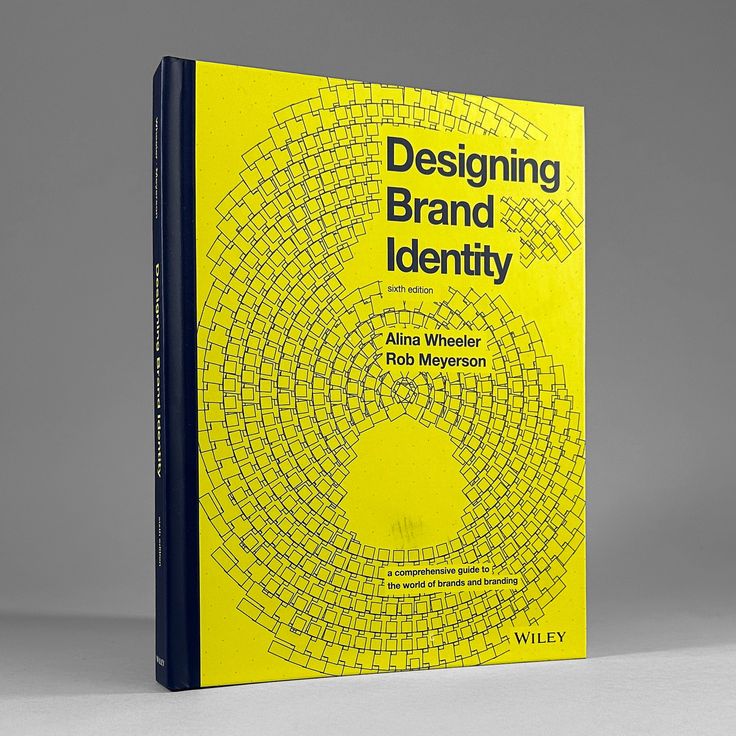
- What makes it great: This is the most complete brand identity book available. It’s used in design schools and professional agencies worldwide. The examples come from real projects with real budgets and real constraints.
- What you’ll learn: How to conduct brand research. How to develop positioning strategies. How to create complete identity systems. How to write brand guidelines. How to manage large branding projects.
- Best for: Designers who want to work on brand strategy, not just execution. Perfect for anyone moving from junior to mid-level positions in agencies or in-house teams.
- Why you need it: If you want to charge more and work on bigger projects, you need to understand branding at this level.
5. Don’t Make Me Think by Steve Krug
Steve Krug wrote this book about web usability, but the lessons apply to all design. The title says that all good design shouldn’t make people think hard about how to use it.
The book uses screenshots and examples to show the difference between confusing websites and intuitive ones. Krug explains why people scan rather than read, why first impressions matter, and why conventions exist for a reason.
One of the most practical chapters covers usability testing. Krug shows you how to test your designs with real users, even if you have no budget or time. His approach is simple: grab three people, watch them use your site, and fix the obvious problems. Repeat.
The book also covers navigation design, mobile usability, and how to win arguments about design decisions using data instead of opinions. Krug writes with humor and doesn’t waste words; the whole book is short and easy to read.

- What makes it great: This book changed how people think about web design. Before it, designers focused on making sites look cool. After it, designers focused on making sites work well. The advice is still relevant 20+ years later.
- What you’ll learn: Basic usability principles. How people actually use websites (not how designers think they do). How to test your designs quickly and cheaply. How to make navigation intuitive.
- Best for: Anyone designing websites, apps, or digital products. Also useful for graphic designers who want to understand user-centered thinking.
- Why you need it: You can’t design good digital products without understanding usability. This is one of the most practical graphic design books out there. It teaches you how to design for real people, not just make things look good
6. Grid Systems in Graphic Design by Josef Müller-Brockmann
Josef Müller-Brockmann was a Swiss designer who helped define the “Swiss Style” of clean, organized design. This book is his guide to using grids in everything from posters to books to websites.
The book explains how grids create structure and rhythm in layouts. Müller-Brockmann shows dozens of grid systems: simple two-column grids, complex multi-column grids, and modular grids that can adapt to different content.
What makes this book special is the visual examples. You see the grid structure overlaid on finished designs, so you understand exactly how the system works. The examples come from posters, brochures, books, and signage systems.

The book also covers when to use different grid types. Simple grids work for straightforward content. Complex grids handle varied content like magazines with photos, text, and sidebars. Müller-Brockmann explains the logic behind each choice.
There’s also a philosophical section about why structure matters. Grids aren’t just about making things look neat, they help readers process information efficiently. Good grids are invisible but do important work.
- What makes it great: This is the definitive book on grid systems. It’s been in print for over 40 years because the principles still work perfectly for modern design, including responsive websites.
- What you’ll learn: How to create grid systems for different types of content. How to use grids without making everything look rigid. How grids improve readability and visual hierarchy. How Swiss design principles apply to modern work.
- Best for: Intermediate designers working on multi-page layouts, magazines, websites, or apps. Anyone who struggles with organizing complex information.
- Why you need it: Once you understand grids, layout design becomes much easier. You’ll have a system instead of guessing where things should go. This is one of the most important graphic design books for anyone serious about structure.
7. Steal Like an Artist by Austin Kleon
Austin Kleon’s book is different from other design books. It’s short, visual, and focused on creativity rather than technique. The main idea: every artist learns by copying people they admire, then gradually develops their own style.
The book has ten chapters, each covering a different way to stay creative. Kleon talks about keeping a “swipe file” of inspiration, using constraints to boost creativity, and why side projects matter. He uses drawings, diagrams, and short paragraphs instead of long explanations.
One powerful idea from the book: you are the combination of your influences. Instead of trying to be completely original (which is impossible), embrace what you love and remix it. Show your work, connect with other creators, and be open about what inspires you.
Kleon also covers practical topics like dealing with creative blocks, knowing when work is “done,” and balancing day jobs with creative projects. The advice is honest and realistic; he knows being creative is hard work.

- What makes it great: This book gives you permission to learn by copying and mixing influences. That’s how every designer actually learns, but people feel guilty about it. Kleon explains why it’s natural and good.
- What you’ll learn: How to find and use inspiration ethically. Why creative blocks happen and how to overcome it. How to develop your own style gradually. Why sharing your work matters.
- Best for: Beginners who feel intimidated by “real” designers. Anyone experiencing creative block or impostor syndrome. Designers who want to be more creative, not just more technical.
- Why you need it: For any designer feeling stuck or overwhelmed, this is a refreshing pick among graphic design books. It reminds you why creativity is a journey, not a destination.
8. The Design of Everyday Things by Don Norman
Don Norman is a cognitive scientist who studies how people interact with products. This book looks at everyday objects, doors, stoves, phones, faucets and explains why some are easy to use while others frustrate us.
Norman introduces key concepts like affordances (what an object suggests you can do with it), signifiers (clues about how to use it), and feedback (how the object responds to your actions). These ideas are fundamental to user experience design.
The book has plenty of funny examples of bad design. Doors that push when you expect them to pull. Stove controls that don’t match which burner they control. Hotel shower controls that require a PhD to understand. Norman explains exactly what’s wrong and how to fix it.
Later chapters cover human error, how people make mistakes, and how good design prevents errors instead of blaming users. This is crucial for anyone designing products that people depend on medical equipment, car dashboards, software interfaces.
The book also discusses design thinking as a process. Norman shows how to research user needs, prototype ideas, and test them with real people. These methods are now standard in tech companies worldwide.
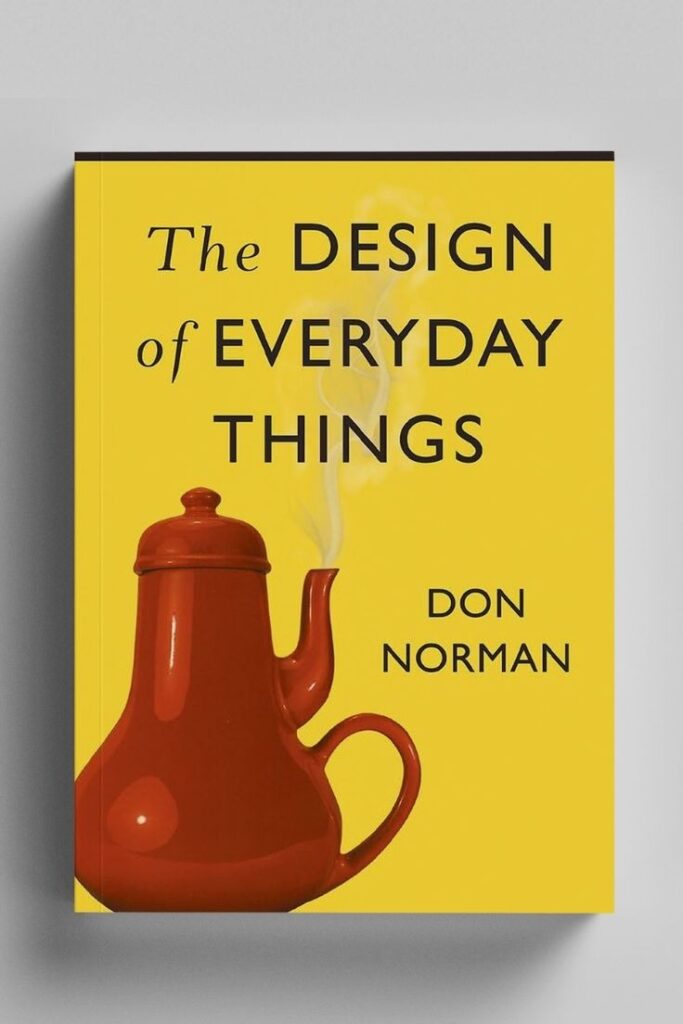
What Makes This Graphic Design Book Essential
- What makes it great: This book changed how people think about design. It’s not about making things pretty, it’s about making things work for humans. The examples stick in your memory forever.
- What you’ll learn: Core UX principles that apply to everything you design. Why people make mistakes and how design can prevent them. How to think about user needs before visual style. The basics of the user-centered design process.
- Best for: All designers, but especially valuable for anyone designing products, interfaces, or services that people interact with daily.
- Why you need it: Whether you design apps, websites, products, or physical spaces, you need to understand how humans think and behave. This is one of the most insightful graphic design books that helps in how design affects behavior, usability, and experience..
9. Making and Breaking the Grid by Timothy Samara
While Müller-Brockmann’s book teaches grid rules, Samara’s book teaches when to break them. The book shows two things: how to create solid grid-based layouts, and when expressive, rule-breaking layouts work better.
The book is organized into sections on different grid types: manuscript grids, column grids, modular grids, and hierarchical grids. Each section shows examples of both conventional layouts and experimental ones that break the grid intentionally.
What makes this book valuable is that Samara explains why breaking the grid works in certain contexts. Breaking rules randomly creates chaos. Breaking rules intentionally creates energy and emotion while still communicating clearly. There’s a big difference.
The book includes over 200 examples from posters, books, magazines, and websites. Each example is analyzed in detail. You see the underlying grid structure (even in layouts that look chaotic), and Samara explains the designer’s choices.
There’s also practical advice about when to use structure and when to loosen up. Corporate annual reports need clear grids. Music festival posters can be more experimental. Understanding context helps you make appropriate choices.

- What makes it great: Most design books teach either structure or creativity. This one teaches both and shows how they work together. The examples are inspiring without being impractical.
- What you’ll learn: How to build flexible grid systems. When and how to break grids effectively. How to balance structure with expression. How to create dynamic layouts that still organize information clearly.
- Best for: Intermediate to advanced designers who understand basic grids but want more creative flexibility. Anyone working on editorial design, posters, or branding where expression matters.
- Why you need it: If you already use grids but want more expressive flexibility, this book teaches how to balance discipline and creativity, a rare lesson in graphic design books.
10. White Space Is Not Your Enemy by Kim Golombisky and Rebecca Hagen
This book explains design fundamentals without using confusing jargon or theory. The authors are professors who got tired of students struggling with overly complicated textbooks.
The book covers the basic design principles of contrast, repetition, alignment, and proximity (CRAP). But instead of abstract explanations, the authors use before-and-after examples that show exactly what each principle does. You see the problem, then you see it fixed.
One chapter focuses on typography basics: when to use different fonts, how to set body text, how to create emphasis without using too many font styles. Another chapter covers color theory in practical terms not color psychology, but how to use color to organize information and create mood.
The book includes exercises at the end of each chapter. These aren’t busywork, they’re focused practice that helps concepts stick. The writing style is conversational and sometimes funny, which makes dry topics easier to digest.
There’s also a chapter on working with non-designers, how to explain your design choices, how to respond to feedback like “make it pop,” and how to guide clients toward good decisions. This alone is worth the price of the book.

Inside This Graphic Design Book: Highlights & Benefits
- What makes it great: This is the most beginner-friendly design book available. The authors don’t show off their knowledge, they genuinely want to help you understand. The examples come from student work, not just professional projects, so they feel achievable.
- What you’ll learn: Core design principles explained simply. How to use white space effectively. Typography basics for different types of content. How to talk about design with clients and stakeholders.
- Best for: Complete beginners with no design background. Also great for marketers, small business owners, or anyone who needs basic design skills for their job.
- Why you need it: If you feel intimidated by design or confused by technical terms, start here. Once you understand these basics, other books will make much more sense.
11. How to Be a Graphic Designer Without Losing Your Soul by Adrian Shaughnessy
Design school teaches you how to design. This book teaches you how to survive as a working designer. Adrian Shaughnessy has run design studios and worked with countless designers, so he knows what really happens in professional practice.
The book covers topics most designers learn the hard way: how to price your work without undercharging, how to find clients without being sleazy, when to turn down projects, and how to deal with clients who don’t respect your time or expertise.
One chapter focuses on staying creative while paying bills. Shaughnessy is realistic about commercial constraints but shows how to maintain your creative standards. He also discusses ethical issues, what projects to avoid, how to handle conflicts of interest, and when money isn’t worth compromising your values.
The book includes practical advice about setting up a studio or going freelance. How do you write proposals? What should contracts include? How do you handle late payments? What insurance do you need? These boring-but-crucial topics can make or break a design career.
There are also chapters on building a portfolio, getting your work published, entering competitions, and promoting yourself without feeling gross. Shaughnessy covers self-promotion for introverts who hate marketing themselves.

Why This Graphic Design Book Matters
- What makes it great: This book tells the truth about the design business. Shaughnessy doesn’t sugarcoat the difficulties, but he also shows that it’s possible to make a living doing what you love while maintaining your integrity.
- What you’ll learn: How to price design work appropriately. How to find and keep good clients. How to say no to bad projects. How to handle contracts and payments. How to promote yourself authentically.
- Best for: New professionals and freelancers. Anyone struggling with the business side of design. Designers who feel exploited by clients or underpaid for their work.
- Why you need it: Being talented isn’t enough. You need business skills to survive as a designer. This book provides them in clear, practical terms.
12. 100 Ideas That Changed Graphic Design by Steven Heller and Véronique Vienne
This book is a visual history of graphic design told through 100 key innovations. Each idea gets a two-page spread with an explanation and visual examples. It’s organized chronologically from medieval manuscripts to digital design.
You’ll learn about movements like Art Nouveau, Bauhaus, and Swiss Modernism not just what they looked like, but why they happened and what they contributed to design. The book also covers technical innovations like lithography, offset printing, and Photoshop.
What makes this book different from typical history books is the focus on ideas, not just famous designers or beautiful work. How did grid systems change design? What did photomontage enable? How did punk aesthetics influence typography? These concepts matter more than memorizing names and dates.
Each entry explains how the idea originated, how it evolved, and how it influences design today. You’ll see connections between old printing techniques and modern digital tools. You’ll understand why certain design conventions exist and whether they still make sense.
The book is heavily illustrated with high-quality reproductions. You see original posters, book covers, magazines, and advertisements from each era. The visual examples make the concepts concrete instead of abstract.
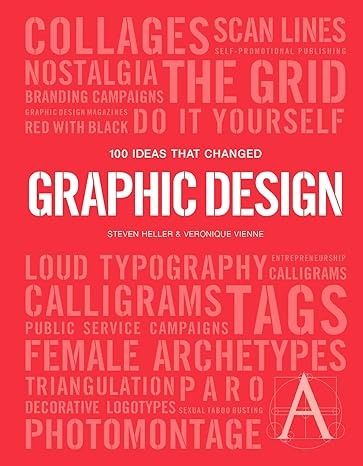
Why This Graphic Design Book Matters
- What makes it great: This book gives you context for modern design practice. When you understand where ideas came from, you can use them more thoughtfully instead of just copying trends.
- What you’ll learn: Major design movements and their contributions. How technology shapes design possibilities. Where common design conventions originated. The evolution from hand-drawn to digital design.
- Best for: All designers, but especially valuable for self-taught designers who missed formal design history education. Also great for anyone interested in visual culture beyond just graphic design.
- Why you need it: Design doesn’t exist in a vacuum. Understanding history helps you see your work as part of an ongoing conversation, which makes you more thoughtful and less trendy.
13. Creative Confidence by Tom and David Kelley
The Kelley brothers founded IDEO, one of the world’s most innovative design firms. This book shares their approach to building creative confidence, the belief that you can solve problems creatively even if you don’t consider yourself “creative.”
The book argues that everyone has creative potential, but many people have it beaten out of them by bad teachers, harsh criticism, or cultures that value following rules over exploring ideas. The Kelleys share stories of people who rediscovered their creativity and what changed for them.
One major focus is design thinking as a methodology. The Kelleys explain their process: empathize with users, define problems clearly, ideate many solutions, prototype quickly, and test with real people. They show how this process works for everything from product design to organizational change.
The book includes case studies from IDEO projects redesigning hospital experiences, creating new products for developing countries, and helping companies innovate. Each case study shows how design thinking solves real problems.
There are also practical exercises you can try: how to run brainstorming sessions that actually generate good ideas, how to prototype ideas cheaply and quickly, and how to test concepts before investing too much time or money.

Why This Graphic Design Book Matters
- What makes it great: This isn’t just about design, it’s about approaching problems with a designer’s mindset. The Kelleys show how design thinking applies to business, education, healthcare, and social issues.
- What you’ll learn: The design thinking process explained clearly. How to facilitate creative problem-solving in teams. How to prototype and test ideas quickly. How to overcome fear of failure.
- Best for: Mid to senior level designers moving into leadership or strategy roles. Anyone who needs to lead creative projects or help non-designers think more creatively.
- Why you need it: As you advance in your career, technical skills matter less and thinking skills matter more. This book develops that strategic, problem-solving mindset.
14. Atomic Design by Brad Frost
Brad Frost created a methodology for building design systems that’s now standard in tech companies. The book explains how to design interfaces using reusable components that work together consistently.
The “atomic” metaphor works like this: atoms are the smallest elements (buttons, input fields, labels). Molecules combine atoms (a search form). Organisms combine molecules (a website header with logo, navigation, and search). Templates show how organisms work together (a page layout). Pages are specific instances (the actual homepage with real content).
This approach solves a huge problem: keeping design consistent across hundreds of pages and screens. Instead of designing each page from scratch, you build a system of components that can be combined in different ways. Change a button style once, and it updates everywhere.
The 2025 edition includes new sections on AI integration, accessibility requirements, and how to document design systems so developers and designers stay aligned. Frost also covers governance how to maintain systems as teams grow and products evolve.
The book is highly practical with code examples, tool recommendations, and case studies from companies like Airbnb, IBM, and Shopify. You see how real design systems are structured and maintained at scale.

Key Highlights
- What makes it great: If you’re designing any digital product, you need to understand design systems. This book teaches the most widely-used methodology. The 2025 edition keeps it current with modern tools and practices.
- What you’ll learn: How to build modular design systems. How to name and organize components. How to create documentation developers will actually use. How to maintain consistency across large products.
- Best for: UI/UX designers working on apps, websites, or design systems. Product designers in tech companies. Anyone designing digital products that need to scale.
- Why you need it: In today’s world of component libraries and design systems, this is one of the most practical graphic design books for UI/UX designers working in tech.
15. Best Graphic Design Books for Ethics in Design- Ruined by Design by Mike Monteiro
Mike Monteiro is angry, and this book explains why. He argues that designers have ethical responsibilities they’re not taking seriously. Facebook’s news feed, Twitter’s harassment problems, addictive slot-machine interfaces are designed decisions with real consequences.
The book challenges designers to think beyond making things look good or work well. Are you designing features that manipulate people? Are you working for companies whose products harm society? If you are considering who benefits and who gets hurt by your designs?
Monteiro covers concrete issues: designing for accessibility isn’t optional, it’s a civil rights issue. Collecting user data isn’t neutral; you’re responsible for how that data gets used. Creating addictive interfaces isn’t a smart growth strategy, it’s exploiting human psychology for profit.
The book also addresses professional issues. Designers should have the power to say no to unethical requests. Design organizations should have codes of ethics like medicine and law. Designers need to see themselves as having agency and responsibility.
Monteiro writes with anger and urgency because he believes designers have power and aren’t using it wisely. He wants designers to question what they build and for whom. The tone is confrontational, but the points are important.

Takeaways from this book
- What makes it great: Most design books avoid ethics entirely or treat it as a nice bonus topic. Monteiro puts ethics at the center. Whether you agree with all his points or not, he’ll make you think critically about your work.
- What you’ll learn: How to evaluate the ethical implications of design decisions. Why “just following orders” isn’t good enough. How to push back on unethical requests from employers or clients. What responsibility designers have for the impact of their work.
- Best for: All designers, but especially important for anyone working at platforms, apps, or companies with millions of users. The impact of your decisions scales with your audience.
- Why you need it: Design isn’t neutral. Everything you create affects people. This book helps you think through those effects and make better choices.
3 Hidden Gems: Specialized Books for Graphic Designers
In Progress by Jessica Hische
Jessica Hische is one of the world’s best lettering artists. This book shows her complete process for one project from initial brief to finished artwork. You see every messy sketch, every revision, every client note.
The book is valuable because it destroys the myth that professional work flows effortlessly from talented people’s brains. Hische shows that even she creates terrible first drafts, experiments with dozens of directions, and sometimes starts over completely.
Each spread shows the evolution of ideas with Hische’s commentary explaining what worked, what didn’t, and why she made each choice. You learn how to evaluate your own work objectively, when to push ideas further, and when to kill them and try something new.

For: Illustrators, lettering artists, and anyone who thinks their process is too messy or slow. Seeing a pro’s real process, not the polished portfolio version, is incredibly reassuring and educational.
Graphic Design Books- Symbols and Logos by Sendpoints
This massive book contains over 3,000 logos organized by visual style, concept, and industry. There’s minimal text, it’s basically a giant inspiration catalog.
Unlike Pinterest, where you find random logos mixed together, this book is curated and organized. You can look up logos based on specific visual treatments (geometric, organic, gradient, lettermark, etc.) or by concept (movement, growth, connection, etc.).
The organization makes it perfect for when you’re stuck on a project. If you’re designing a logo that needs to feel “energetic,” you can flip to that section and see 50 different ways designers have visualized energy. It’s inspired with structure.

For: Brand designers and logo specialists who need visual inspiration organized intelligently. Much better than endless scrolling through uncurated online galleries.
Motion Design Language by Issara Willenskomer
As websites and apps have become more sophisticated, motion design has shifted from optional decoration to expected standard. But most UI designers never learned animation principles because they came from static design backgrounds.
This book teaches motion design specifically for UI designers, not traditional animators. Willenskomer covers timing, easing, choreography, and how motion communicates meaning, all in the context of digital interfaces.
The book explains how motion improves usability by providing feedback, showing relationships between elements, and maintaining context during transitions. It also covers common mistakes like motion that’s too fast, too slow, or just decorative without serving user needs.
For: Digital designers adding motion to their skill set. Product designers who want to specify animations for developers. Anyone working on apps or websites where motion matters.
How to Choose the Right Graphic Design Books
Match Books to Your Current Level
- If you’re a beginner: Start with accessible books that don’t assume prior knowledge. “Thinking with Type,” “White Space Is Not Your Enemy,” and “Logo Design Love” are perfect starting points. Don’t buy advanced books yet, you’ll get frustrated and put them down.
- If you’re intermediate: You know the basics but need depth in specific areas. Get books like “Grid Systems,” “Designing Brand Identity,” or “Don’t Make Me Think” that go deeper into specialized topics. You’re ready for books that don’t explain everything from scratch.
- If you’re advanced: Look for books that challenge your thinking, not just teach techniques. “The Elements of Typographic Style,” “Ruined by Design,” and “Creative Confidence” will push your practice forward. You need strategy and perspective more than technical instruction.
Balance Different Types of Learning
- Theory books explain why things work. Examples: “The Design of Everyday Things,” “Grid Systems.”
- Practice books show how to do specific things. Examples: “Logo Design Love,” “Atomic Design.”
- Inspiration books expand your visual vocabulary. Examples: “100 Ideas That Changed Graphic Design,” “Symbols and Logos.” Business books cover professional survival. Examples: “How to Be a Graphic Designer Without Losing Your Soul.”
- Mindset books develop creative thinking. Examples: “Steal Like an Artist,” “Creative Confidence.”
You need all five types. Only reading technique books makes you skilled but uncreative. Only reading theory makes you knowledgeable but impractical. Mix them.
Focus on Your Specific Goals
- Want to master typography? Read “Thinking with Type,” then “The Elements of Typographic Style.”
- Going freelance? Get “How to Be a Graphic Designer Without Losing Your Soul” and “Logo Design Love.”
- Working on apps? Read “Don’t Make Me Think,” “The Design of Everyday Things,” and “Atomic Design.”
- Doing brand work? Start with “Logo Design Love,” then move to “Designing Brand Identity.”
- Feeling stuck creatively? Try “Steal Like an Artist” and “Creative Confidence.”
Don’t buy books randomly. Get books that solve your current problems or support your next career step.
Prioritize Timeless Principles Over Trendy Techniques
Software books become outdated within months. “Photoshop CC 2024 Tricks” will be useless next year. But books about design principles, typography, color theory, and visual hierarchy stay relevant for decades.
“The Elements of Typographic Style” was published in 1992 and is still the best typography book available. “The Design of Everyday Things” came out in 1988 and remains essential UX reading. These books teach principles that don’t change when new software releases.
Get books about thinking and seeing, not just about using tools. You can always Google how to use the latest Figma features. You can’t Google how to develop good design judgment, that comes from deep learning.
Read Outside Design
The best designers aren’t just good at design they know about psychology, history, business, storytelling, and more. Reading outside design gives you unique perspectives your competition doesn’t have.
Psychology books help you understand users better. Business books teach you how companies make decisions. Art history books expand your visual vocabulary. Marketing books explain how to communicate persuasively.
Some recommendations: “Thinking, Fast and Slow” by Daniel Kahneman (psychology), “Made to Stick” by Chip Heath (communication), “The Mom Test” by Rob Fitzpatrick (user research), “Show Your Work” by Austin Kleon (self-promotion).
Start Building Your Design Library Today
You don’t need to buy all 15 books right now. Start with one that addresses your biggest current challenge.
- Struggling with typography? Get “Thinking with Type.”
- Confused about grids and layout? Get “Grid Systems in Graphic Design.”
- Need to understand users better? Get “Don’t Make Me Think.” Going freelance?
- Get “How to Be a Graphic Designer Without Losing Your Soul.” Feeling creatively stuck? Get “Steal Like an Artist.”
Read it fully. Take notes. Try the exercises if it has them. Apply what you learn to your actual projects. Then come back and get another book.
The designers who keep improving are the ones who keep learning. These graphic design books give you decades of knowledge compressed into a few hundred pages. That’s a much better investment than another software course that’ll be outdated in six months.
Good design takes practice, but it also takes knowledge. Start reading today.

